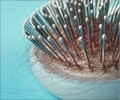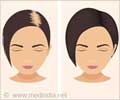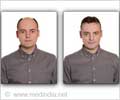Different health conditions could be revealed by our hair besides disclosing our adherence to fashion, say experts.

Here are the eight things that would tell you it's time to pay more attention to the health of your hair and to your overall health in general.
1. Dry, limp, thin-feeling hair
What it means: Many factors can lead to over-dry hair, including hair dyes, hair blowers, and swimming in chlorinated water. But a significant change in texture that leaves hair feeling finer, with less body, can be an indicator of an underactive thyroid, known as hypothyroidism.
More clues: Other signs of hypothyroidism include fatigue, weight gain, slow heart rate, and feeling cold all the time, said Raphael Darvish, a dermatologist in Brentwood, California.
What to do: Get the levels of thyroid hormone checked. The most common blood tests measure the levels of thyroid-stimulating hormone (TSH) and T4.
Advertisement
What it means: When a thick crust forms on the scalp, this usually indicates psoriasis, which can be distinguished from other dandruff-like skin conditions by the presence of a thickening, scab-like surface, said Lawrence Greene, a spokesperson for the National Psoriasis Foundation.
Advertisement
What to do: There's a long list of ingredients that help relieve psoriasis, and treatment is often a process of trial and error. Topical treatments include shampoos containing coal tar or salicylic acid, and creams or ointments containing zinc and aloe vera. Hydrocortisone cream works to relieve inflammation. Prescription creams include vitamin D, vitamin A, and anthralin. Many patients also have great success treating the scalp with UV light therapy, and systemic medications such as cyclosporine work better for some people than topical medications.
3. Thinning hair over the whole head
What it means: When you notice considerably more hairfall, a common cause could be a sudden psychological or physical stressor, such as a divorce or job loss. Another could be having a high fever from the flu or an infection. Diabetes can also cause hair to thin or start to fall out suddenly.
A number of medications and hormonal changes also cause hair loss as a side effect.
What to do: If you have what experts call temporary hair loss-to distinguish from hereditary hair loss, which is likely to be permanent-you'll need to discontinue the medication or treat the underlying condition that's causing the problem. Vitamin D can help hair follicles recover.
4. Overall hair loss that appears permanent, often following traditional pattern baldness
What it means: Both women and men are subject to what's formally known as androgenetic and androgenic alopecia. It's usually caused by a change in the pattern of the sex hormones, but diseases and other underlying conditions can cause this type of hair loss by affecting the hormones.
Men's hair loss nearly always follows a pattern of thinning along the hairline, at the temples, and in the back of the scalp. Some women's hair loss also follows this pattern, but more typically women experience thinning over the entire head.
More clues: Many drugs taken long-term to control chronic conditions can have a side effect, in some people, of causing or contributing to hair loss. They include beta blockers such as propranolol and atenolol, anticoagulants like warfarin, and many drugs used to control arthritis, Parkinson's disease, and other conditions.
What to do: If you suspect a medication is causing or exacerbating your hair loss, try and find an alternative for it.
5. Dry, brittle hair that breaks off easily
What it means: When individual hair litter your pillow in the morning, this typically indicates breakage rather than hair falling out from the follicle, said Chicago dermatologist Victoria Barbosa. Breakage is most frequently the result of hair becoming over-brittle from chemical processing or dyeing.
However, certain health conditions also lead to brittle, fragile hair. Among them: Cushing's syndrome, a disorder of the adrenal glands that causes excess production of the hormone cortisol. A condition called hypoparathyroidism, usually either hereditary or the result of injury to the parathyroid glands during head and neck surgery, can also cause dry, brittle hair.
More clues: If the cause of your dry, brittle hair is an underlying health condition, you'll likely notice additional symptoms, such as dry, flaky skin. Overly dry hair also can signify that your diet is lacking in omega-3 fatty acids, which are found in salmon and fish oil, as well as many nuts and seeds, particularly flaxseed.
What to do: No matter what the cause of your dry, brittle hair, minimizing heat and chemical treatment are necessary for it to get healthy again. If an underlying condition is throwing your hormones out of whack and in turn affecting your hair, talk to your doctor. The symptoms of hypoparathyroidism, for example, are often reduced or eliminated with supplemental vitamin D and calcium.
6. Hair falling out in small, circular patches
What it means: The body's immune response turns on the hair follicles themselves, shrinking them and causing hair to fall out entirely in small, typically round patches. This kind of hair loss -- which experts call alopecia areata-can also occur at the temples or at the part line.
More clues: Alopecia areata can also cause the eyebrows or eyelashes to fall out, which in addition to the circular pattern can distinguish it from other types of hair loss.
What to do: The treatment most proven to work against alopecia areata is cortisone shots delivered directly into the scalp in the spots where the hair is falling out. "If you don't get steroid injections, the circular patches will get larger and more cosmetically noticeable," said California dermatologist Raphael Darvish.
7. Yellowish flakes on the hair and scaly, itchy patches on the scalp
What it means: Seborrheic dermatitis is a chronic inflammatory condition of the scalp that causes skin to develop scaly patches, often in the areas where the scalp is oiliest. When the flaky skin loosens, it leaves the telltale "dandruff" flakes.
More clues: One way to differentiate seborrheic dermatitis from plain dry skin: When skin is dry, you'll typically also see dry, scaly skin between the eyebrows and by the sides of the nose, said Darvish. Also, seborrheic dermatitis tends to be seasonal, flaring up during the winter and disappearing in the summertime. It may be triggered by stress as well.
What to do: If it's seborrheic dermatitis "there are great prescription shampoos and creams that can correct this," said Darvish. The most effective treatment for yeast overgrowth is ketoconazole, a newer drug that works by damaging the fungal cell wall, killing the fungus.
8. Gray hair
What it means: Many people perceive gray hair is an indication of stress or trauma. Many researchers now believe that stress may trigger a chain reaction that interferes with how well the hair follicle transmits melanin, the pigment that colors hair.
More clues: The schedule and pattern by which you go gray will most likely follow your parents' experience. However, if you suspect stress is graying you prematurely, keep careful track of stressful events.
What to do: If you believe that stress or trauma is causing your hair to go gray, boost your coping strategies by working on your reactions to stressful situations. Yoga and meditation, for example, are effective stress-management tools.
Source-ANI















